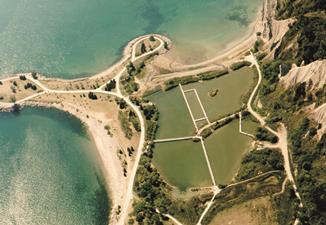Flow Balancing Systems
 Cleaning up degraded waterfront areas is a challenge faced by many cities around the world. Flow balancing systems that treat polluted stormwater and combined sewer overflows offer an innovative solution to this problem. The original concept, developed by Karl Dunkers in Sweden, is a storage device consisting of a series of connected cells created by suspending plastic curtains from pontoons. During a rain event, stormwater or combined sewer overflow enters the first cell, displacing the cleaner water into the second cell. Similarly, the remaining cells are filled in sequence before the polluted water can enter the lake. After the rain event, polluted water stored in the facility is pumped to a wastewater treatment plant while clean water from the lake or ocean refills the cells. Flow openings in the perforated curtains separating the cells are spaced in a manner that optimizes the length of time water resides in the facility by reducing the potential for short circuiting of flow.
Cleaning up degraded waterfront areas is a challenge faced by many cities around the world. Flow balancing systems that treat polluted stormwater and combined sewer overflows offer an innovative solution to this problem. The original concept, developed by Karl Dunkers in Sweden, is a storage device consisting of a series of connected cells created by suspending plastic curtains from pontoons. During a rain event, stormwater or combined sewer overflow enters the first cell, displacing the cleaner water into the second cell. Similarly, the remaining cells are filled in sequence before the polluted water can enter the lake. After the rain event, polluted water stored in the facility is pumped to a wastewater treatment plant while clean water from the lake or ocean refills the cells. Flow openings in the perforated curtains separating the cells are spaced in a manner that optimizes the length of time water resides in the facility by reducing the potential for short circuiting of flow.
The Dunkers Flow Balancing System (DFBS) is typically constructed on the shores of a lake or ocean. In general, construction costs are low relative to other facilities providing the same level treatment because the facility is not constructed on land, and the materials used are simple and light weight. These facilities are also aesthetically pleasing and may provide a healthy habitat for aquatic organisms and wildlife.



